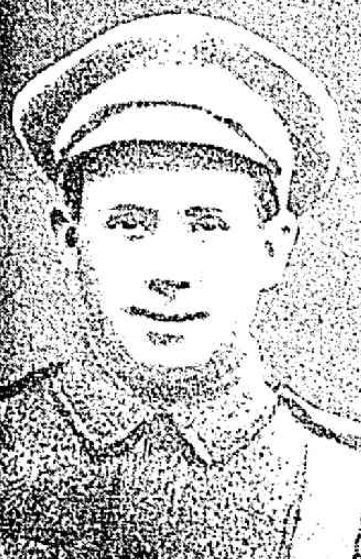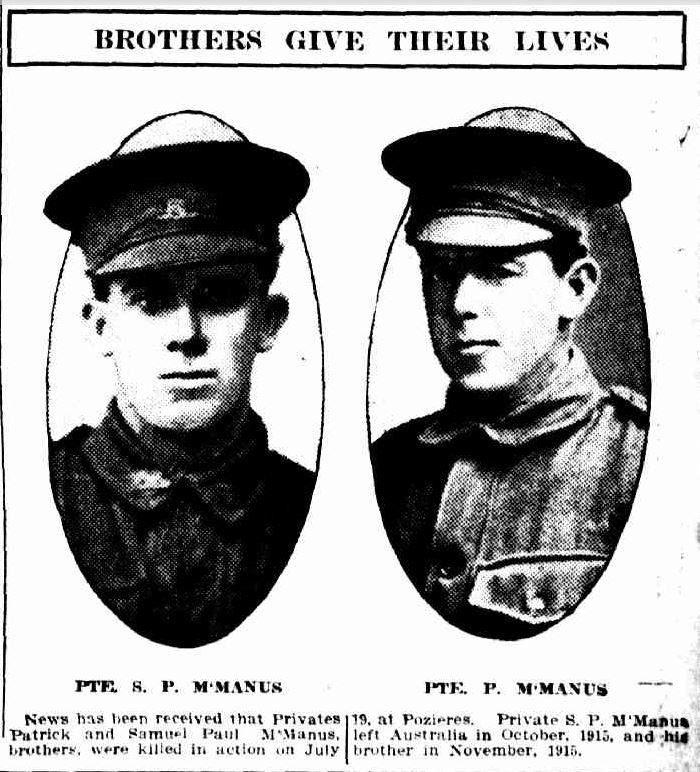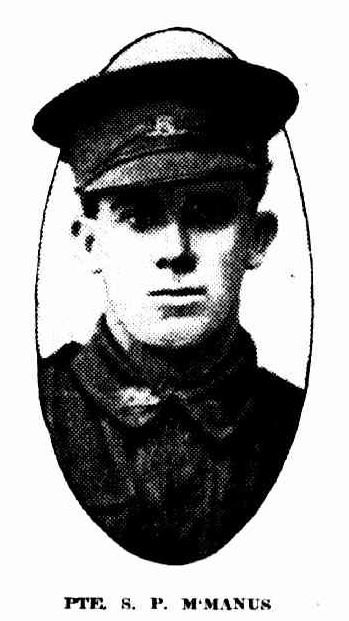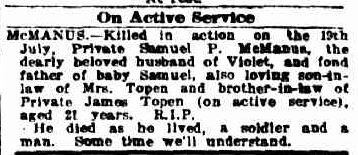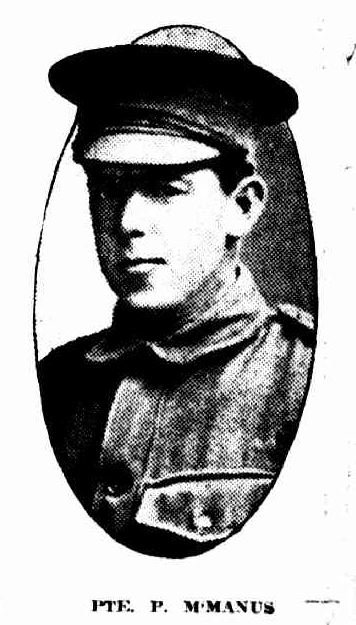
Patrick John MCMANUS
Eyes blue, Hair black, Complexion sallow
The McManus Family Story
Patrick McManus and Catherine Hitchcock had married in 1883 in Quorn, South Australia but moved to Victoria where they had four sons and two daughters. Johanna was born in 1884, Thomas in 1886, Alfred in 1888, Patrick John in 1891, Catherine Anne in 1893 and Samuel Paul in 1895. Johanna and Thomas were born in Warraknabeal in country Victoria, while the other children were born in South Melbourne.
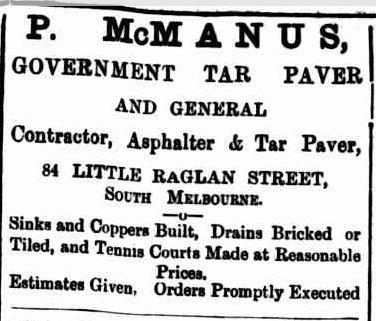
Their father Patrick died young, in about 1901, leaving Catherine dependant on her children for support of the family. By 1916, three of the six children were married – Johanna (married 1904 to Ben Norman Matthews), Sam (married 1915 to Violet May Topen) and Catherine (married 1916 to Frank Lewis).
In 1915 Tom and Alf were working as labourers, Pat was a driver and Sam was a mill carter.
Four Brothers in Arms - The Call to War 1915
As with many young Australian men, there was a widely held belief that they were a part of the British Empire and that their support for the war would 'prove' Australia as a new nation. As the war went on, the soldiers also developed a sense of identity distinct from the British soldiers which was a source of pride.
Sam, the youngest, felt the call to war first, enlisting on 21 January 1915. He was only 20 at the time but stated his age as 21; he was accepted and sent to start his training at the Broadmeadows camp in Melbourne.
However, his mother was NOT supportive and wrote to the AIF at the end of March:
“I want you to grant my son Sam McManus his discharge, as he is out at Broadmeadows against my will and I believe they are soon going away and I don’t want him to go away. It would break my heart if he was to go to war. He is the youngest in the family……”
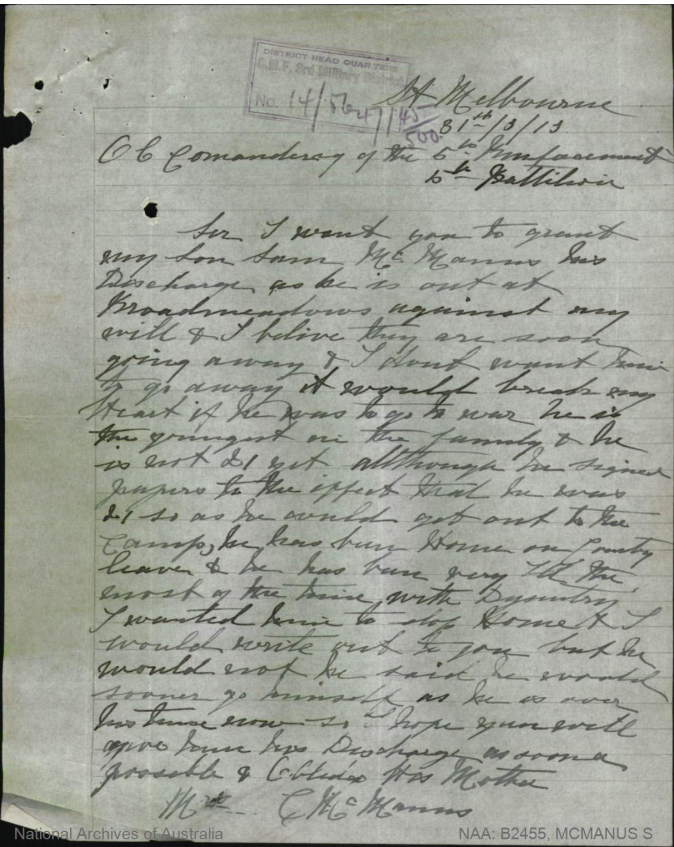
Being underage and without permission from his family, Sam was discharged on 4 April after just 10 weeks. Soon after, Sam married Violet May Topen. While his recent marriage and knowing his mother’s wishes might have made him reconsider his desire to go to war, it seems however he did not. Sam reenlisted on 17 July 1915 when he WAS 21.
His brothers were also joining the cause at the time: Pat enlisted on 6 July 1915, Alf on 9 July and Tom on 19 July. So, within a fortnight, four brothers enlisted to serve King and country – all were given the rank of Private and they were allocated across three different Battalions:
- Sam, aged 20 – 22nd Battalion
- Pat, aged 23 – 7th Battalion
- Alf, aged 26 – 22nd Battalion
- Tom, aged 28 – 23rd Battalion
Despite Sam and Alf being allocated to the same Battalion, it was Sam (22nd) and Tom (23rd) who left Australia together on HMAT A38 Ulysses on 27 October 1915. Pat (7th) soon followed his youngest and his oldest brothers to Egypt on 23 November while Alf (22nd) did not leave Australia until 8 February 1916.
Once in Egypt, the McManus brothers continued their training and support of the defence of the Suez Canal in several locations. With all the new recruits arriving in Egypt and new battalions being formed for support of the Western Front, there were many re-assignments of the soldiers. By mid-March, three of the brothers (Sam, Pat, Tom) had been assigned to the 60th Battalion after having short stints in the 58th and 59th Battalions. Within the 60th, Tom was appointed as a driver in March 1916 while Pat and Sam remained in the infantry.
In contrast, Alf remained with the 22nd Battalion but only arrived in Egypt on 21 March – just in time to leave six days later for France and the Western Front.
Before the Battle – Alf’s time in Fleurbaix / Fromelles
Alf arrived with the 22nd Battalion in the front line in Fleurbaix on 7 April 1916. While there, the 22nd made improvements to the trenches amidst ongoing bombing and sniping and machine gun fire from the German positions. At the end of April, they were relieved from the front lines and moved to Erquingham, 5 kilometres away.
In early June, Alf was moved back to the front in the Bois Grenier Line. He remained there until 4 July as the 22nd was being moved from Fleurbaix, in preparation for other battles in the Somme.
As Alf was being moved out, Tom, Pat and Sam were being moved in.
Fleurbaix / Fromelles–Pat, Sam, and Tom
The 60 officers and 975 enlisted men of the 60th embarked in Alexandria on the transport ship Kinfauns Castle in mid-June 1916. After a stop in Malta, they arrived in France on 29 June. Boarding a train in Marseilles, they arrived in Steenbecque on 2 July, just as Alf was being moved out of the Fleurbaix region.
Upon arrival, the three brothers were sent straight into the trenches on 13 July. Three days later they were in position for an attack but it was postponed due to unfavourable weather. There was a gas alarm while they waited in the trenches, but luckily it was just that.
On the 19th, they were again readying for an attack and were in position in the trenches by 4.20 p.m. There was ongoing heavy artillery from both sides. The first wave of Aussies went over the parapet at 6.45 p.m. with the last wave going over at 7.00 p.m.
The 60th were in a very difficult position. With ongoing bombardment, they faced short range fire from the German trenches and cross-fire from the machine gun emplacement on the Sugar Loaf salient, just a short distance away. One soldier said that their unit only got to within 90 yards of enemy trenches, but another said he “believed some few of the battalion entered enemy trenches and that during the night a few stragglers, wounded and unwounded, returned to our trenches.”
Fighting continued through the night. With the known heavy casualties in the 60th, they were relieved by the 47th Battalion at 7a.m.
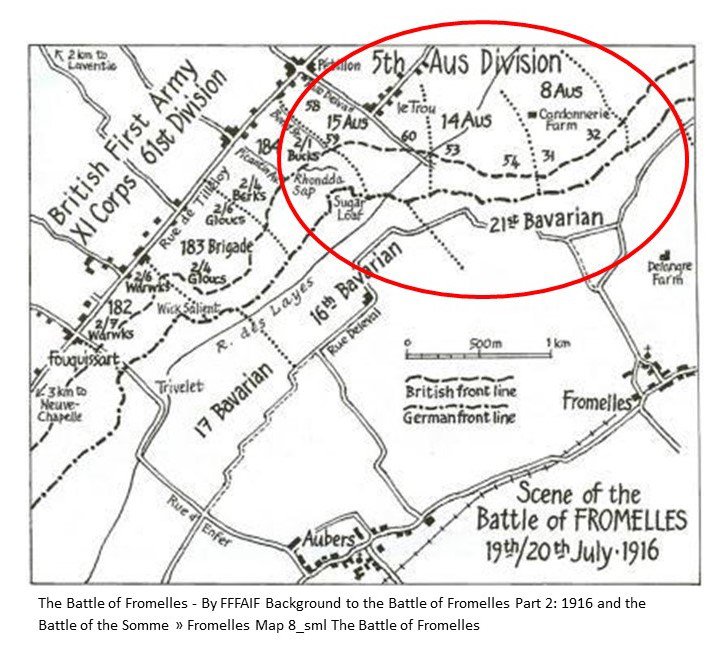
Roll call was held at 9.30 a.m. In the Official History of the War, Bean said “of the 60th Battalion, which had gone into the fight with 887 officers and men, only one officer and 106 answered the call”. None of the three McManus brothers answered that 9.30 a.m. roll call.
Patrick was the first of the brothers to fall. His mate, Lance Corporal John Moloney, 2742, reported that Pat was shot in the stomach as he went over the parapet and, while being helped, died immediately after. His identity disc was recovered, but his body remained in no-man’s land.
Sam was next, and not long after Pat.
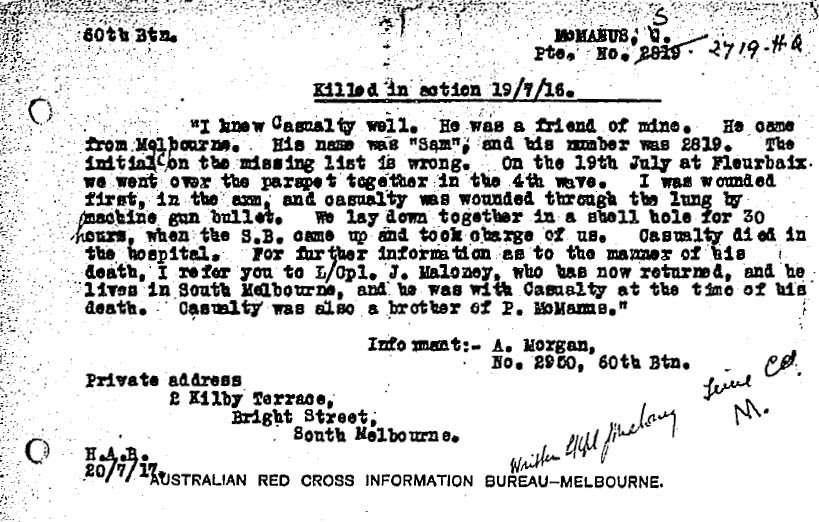
He had gone over in the fourth wave. His friend, Albert Morgan, 2950, who was also wounded, reported that Sam was shot through the lung and that he was taken to hospital, but there are no records to support that he made it that far. Sam’s body remains missing to this day.
The third of the McManus brothers in the 60th Battalion, Tom, was reported as being killed in several reports and officially reported as missing in action, but – in hindsight - it is evident that he had been mixed up with his brothers amidst the ferocity of the battle. One report stated that he had not actually been in the attacking waves. Tom later confirmed he had been in Battalion Transport and did survive, but that he did know of the death of his two brothers at the time.
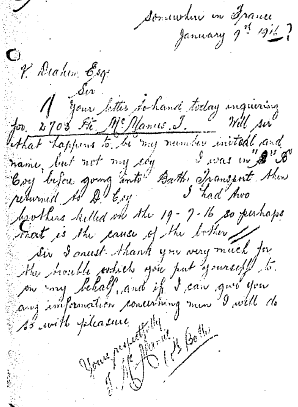
After the Battle - Alf and Tom
After leaving Fromelles in early July, Alf headed south with the 22nd to prepare for battle in Pozieres, part of the massive British attacks on the Somme. During the first phase of this battle – on 27 July - Alf was badly wounded suffering a gunshot wound in the elbow. He was evacuated by hospital ship to England where he underwent some months recuperating. He eventually re-joined his unit in France in January 1917 but fell ill again shortly after and spent a further three weeks in hospital before finally recovering.
Tom was assigned to the 15th Infantry Brigade HQ from 13 November 1916 but returned to the 60th Battalion in mid-March 1917.
Both Alf’s and Tom’s units spent most of 1917 bogged in trench warfare. For Alf and the 22nd, this included Bullecourt in France and Broodseinde in Flanders. Tom and the 60th served in the advance that followed the German retreat to the Hindenburg Line and in support of the major battle at Polygon Wood on 26 September 1917. Their units also supported fights against the German Spring Offensive in the Somme that began in March 1918.
The successful battle for Ville-sur-Ancre on 19 May 1918 was Alf’s last encounter with the Germans.
Tom was in in the battle at Villers-Bretonneux on 25 April 1918, the world's first battle between two tank forces. He was reassigned to the 59th Battalion on 25 September 1918 and was at the Battle of St Quentin Canal which resulted in the first full breach of the Hindenburg Line. He saw no further action after that.
The Call from Home
Military authorities in Europe and in Australia did their best to keep families informed but the immediate priorities of war, long distances, limited communication channels as well as the confusion and aftermath of dreadful battles such as Fromelles made delays and errors almost inevitable.
In the case of Fromelles, there were often far too few who survived and were able to provide information about those who died or were wounded. For the McManus family, they suffered many months of little - and sometimes mistaken - information about their four boys.
Hearing rumours of a dreadful battle but having no definite news of their boys must have been traumatic for the McManus family. From the timeline gleaned from the AIF records, it seems that news of Alf’s wounding at Pozieres was the first official news for the family - just a month after the Battle of Fromelles.
By early September, they were advised that both Pat and Tom had been missing in action since July. Less than a week later (11 Sep), Pat’s death was confirmed but there was no further news of Tom until nearly two months later when the family learned that Tom was safe. News of Sam was non-existent as there was confusion in his paperwork and authorities could not identify his next of kin.
For Violet, her first news of her husband was the forwarding of a letter from Sam that had presumably been lost in transit for more than three months. That letter however helped authorities pinpoint Sam’s identity and family were finally notified in December that Sam had been killed five months earlier.
This must have been a heart-breaking time for the family and we can but hope that they might have at least received mail from Alf in England and perhaps from other mates who had survived Fromelles.
Behind the scenes, Catherine had her daughter Kate’s husband Frank contact the Army in March 1918 about getting her two remaining sons home. He wrote, “(She) gave her 4 sons to the Empire; the two youngest being reported killed in Action on July 19th 1916.”
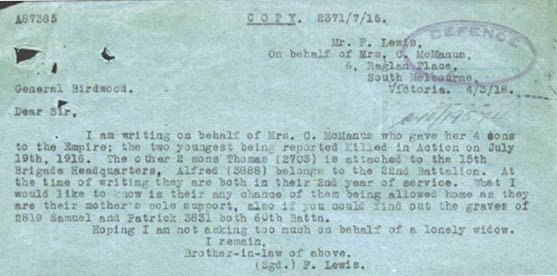
General Birdwood, commander of the Australian forces, was supportive of sending one of them home, likely the eldest. Tom had, unfortunately, chosen an ‘inappropriate’ time to be absent without leave and Alf had a glowing endorsement from his unit, so Alf was the first one to return. By 22 June 1918, he was heading home, arriving on 29 August and discharged on 25 October 1918.

Tom had to wait until the war was winding down and on 8 February 1919, he was finally scheduled to return to Australia. He departed from Liverpool on 4 March, arrived in Australia on 31 May and was discharged on 25 July 1919.
Family – Post War
While no mother should have to lose two sons to war, perhaps the saddest part of the McManus’ family story is not Catherine’s, but Violet’s.
She and Sam had married in May 1915 and Violet became pregnant just before Sam departed at the end of October. Not only was her soldier sweetheart off to war but Violet suffered the loss of her younger sister, Florence Topen who died aged 11 on 17 October 1915 – less than two weeks before Sam embarked for Egypt.
Violet went to live with her mother, Sarah Topen, and later gave birth to a son, Samuel James Anzac McManus, who was born just two months before Sam (snr) died – although Sam junior would be more than six months old before his father’s death was confirmed. Violet suffered another cruel blow when her only surviving sibling, Private James Topen, was killed in Ypres in September 1917. So much loss – and more was to come.

Sam (jnr) later went on to serve in WW II in the 2/4th Anti-Tank Regiment as a Lance Sergeant. Unfortunately, he was captured by the Japanese and died aged 28 in the Sandakan prison camp on Borneo on 27 March 1945.
The two surviving McManus brothers, Tom and Alf, spent the years after the war in the Melbourne area, both working as labourers and packers. Alf married Mary Seiber in 1923 and died in 1961. Tom lived with his mother in Raglan Place until she died in 1934 and then, in 1937, he married widowed Daisy M. C. Harwood; Daisy died in 1949 and Tom in 1950.
Remembrance
Pat and Sam’s bodies were never found.
They are commemorated at the South Melbourne War Memorial and also at the VC Corner Memorial near Fromelles, France, Panel 21 and the Australian War Memorial in Canberra, Roll of Honour, Panel Number 170. Violet and Catherine also received, on behalf of Sam and Pat respectively, the 1915 Star Medal, the British War Medal, and the Victory Medal. Tom and Alf were also awarded medals for their service, though Alf was not eligible for the 1915 Star.
In 2008, a mass grave that had been dug by the Germans outside of Fromelles during the War was discovered. It contained the remains of some 250 soldiers.
With this discovery, there was an Australian Defence Force project to try to match up DNA of the soldiers in the grave with living relatives to be able to honour the soldiers properly. A great many of the soldiers have been confirmed but, as yet, neither Pat nor Sam have been identified.
Sam’s obituary seems to best capture the measure of these brave four brothers:
“He died as he lived, a soldier and a man.
Some time we’ll understand.”
DNA is still being sought for family connections to
| Soldier | Patrick John McMANUS 1891-1916 and Samuel Paul McMANUS 1895-1916 (married Violet Topen) |
| Siblings | Johannah 1884-1966 (married Ben Norman MATTHEWS) | ||
| Thomas 1886-1950 (married Daisy HARWOOD) | |||
| Alfred 1888-1961 (married Mary Florence SEIBER) | |||
| Catherine 1893-1979 (married Frank LEWIS) |
| Parents | Patrick McMANUS b. c1860 - d. c1901 Victoria | ||
| Catherine Mary HITCHCOCK b. 1860 SA d. 1934 Sth Melbourne, Vic |
| Grandparents | |||
| Paternal | Thomas McMANUS and Mother unknown | ||
| Maternal | Alfred HITCHCOCK – married in South Australia and Johanna HENNESSY 1830-1895 – died in Vic |
Seeking DNA Donors

Contacts
(Contact: carla@fromelles.info or geoffrey@fromelles.info).
(Contact: army.uwc@defence.gov.au or phone 1800 019 090).
Donations
If you are able, please contribute to the upkeep of this resource.
(Contact: bill@fromelles.info ).
